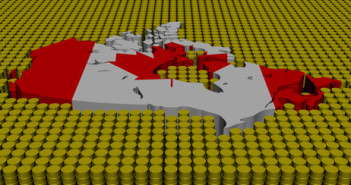The Canadian dollar is fluctuating, but generally suffering from lower oil prices and the consequent rate cut from the Bank of Canada.
What’s next for the loonie? Here are quite a few views:
Here is their view, courtesy of eFXnews:
The Canadian dollar was back on the defensive Wednesday, with the loonie tracking oil prices lower after several sessions of both instruments pushing higher.
Analysts mostly doubted that oil prices would see a sustained pop higher and therefore also doubted that the latest Canadian dollar rally will be long lasting.
Topside targets near C$1.2800 and C$1.3065 (2009 high seen March 9) remained intact – at least for now, they said.
Dollar-Canada was trading at C$1.2558 Wednesday afternoon, on the high side of the day’s C$1.2391/C$1.2592 range.
The loonie and other commodity currencies soared yesterday as oil prices rallied for a second day, but today, with oil back on the defensive, these currencies are being sold again.
Dollar-Canada bottomed at C$1.2352 Tuesday, the lowest level in nearly two weeks.
A decisive break today above yesterday’s peaks near C$1.2644 would suggest the downward correction, seen in recent sessions, has run its course and that dollar-Canada may be headed back to the 2015 peaks near C$1.2799, seen Jan. 30.
“Yesterday’s close below C$1.2503 suggests that a blow-off top has formed and is indicative of short-term exhaustion,†said George Davis, chief technical analyst at RBC Capitial Markets.
“This development sets the stage for a corrective pullback toward initial uptrend support at C$1.2259 as the daily studies attempt to resolve lingering overbought readings,†he noted.
Below that secondary support comes in at C$1.2200 and C$1.1984, Davis said.
On the topside, “With the 1.2503 level reversing roles and serving as initial resistance, we note that prices will have to pierce secondary resistance at C$1.2713 in order to trigger a bullish breakout and reassert the intermediate uptrend,†he said.
RBCCM continued to view any valuation-driven pullbacks to support at C$1.2259 and C$1.1984 “as a strategic buying opportunity based on the intermediate and long-term uptrends that are in place.â€
Davis reminded that their medium-term technical price target at C$1.2700 was already attained on January 30, “and this level remains as our target for the time being.â€
In addition to oil price weakness, the loonie also weakened in response to a much weaker than expected Canadian IVEY PMI report, showing that the headline index fell to 45.4 in January, the lowest level in nearly six years.
The index dropped 10 points from its 55.4 level in December, recording its largest one-month decline since November 2012, when it fell 10.8 points. See MNI mainwire story at 10:56 a.m. ET for details.
The Toronto Stock Exchange’s S&P/TSX was trading down 18 pts at 15,045 at the time of writing.
Canadian stocks outperformed last month, at least compared to U.S. stocks. The TSX was up 0.3% year-to-date in January, compared to the 3.1% year-to-date loss seen in the S&P 500.
The 15,154.92 TSX high seen Tuesday was the highest level seen since November 21, 2014, when the index peaked at 14,184.36.
On January 21, the Bank of Canada unexpectedly, in terms of the timing, lowered the overnight target rate by 25 basis points to 0.75% and subsequently analysts have been penciling in another cut, perhaps as early as March.
Dollar-Canada has risen 6.1% from the C$1.2063 low seen that day, before the BOC announcement, to last Friday’s peaks at C$1.2799 – a sizable run-up in a short amount of time, so a correction is not a surprise.
The loonie will continue to take its cue from swings in crude, traders said, pointing to comments made by BOC Governor Stephen Poloz in the press conference that followed the BOC decision.
Poloz noted that a $60 oil price is “a reasonable number to do our analysis on.â€
“Prices are currently lower, but our belief is that prices over the medium term are likely to be higher,†the BOC said in its Monetary Policy Report.
Using the $60 assumption, the BOC’s first projection “implied that it would take until late 2017 for the economy to use up its excess capacity,†the central bank said.
“This would mean significant downside risk to our underlying inflation profile, which is already below target because of the expected dissipation of one-time inflation effects from meat, communications and dollar depreciation,†the BOC said.
“Obviously, these risks would be even more material if oil were to average $50 a barrel,†the central bank added.
West Texas Intermediate, at $49.75/bl currently, has traded in a $43.58 (Jan. 29) to $54.25 (Feb. 3) range since the BOC decision.
Looking ahead, Canadian employment data is set for release Friday, along with U.S. non-farm payrolls.
CIBC World Market’s Nick Exarhos looked for Canadian jobs to rise by 7,000, versus consensus at 5,000. The unemployment rate is expected to remain steady at 5.7%.
Even at low levels of unemployment the BOC still decided to cut rates in January, “something it’ll likely do again in March,†he said.
“The hit from oil will indeed be major, both to investment and hiring,†he said.
“We should get back to 7% or so levels on the unemployment rate near the middle of the year, as oil sector budget curtailments hit payrolls,†Exarhos said.
For lots more FX trades from major banks, sign up to eFXplus
By signing up to eFXplus via the link above, you are directly supporting Forex Crunch.



